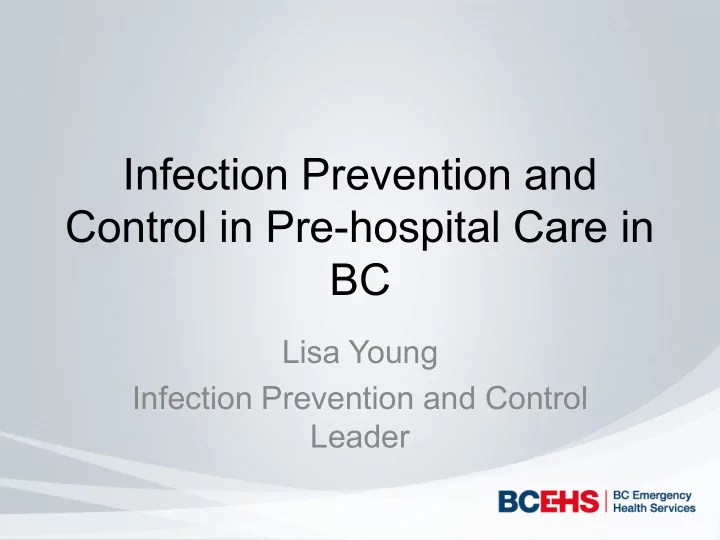

Infection Prevention and Control in Pre-hospital Care in BC Lisa Young Infection Prevention and Control Leader
Objectives To provide some background to BCEHS BCAS PHSA The IPAC challenges in pre-hospital care New ventures Some of the things we have been working on
Once upon a time… 1900’s Pre-hospital care was principally a transport service provided by a wide range of commercial and municipal operators 1970 Foulkes report for the Ministry of Health 1974 The Health Emergency Act 1974 – 1980’s - Transition period Standard setting, training Advanced Life Support, Infant Transport Team Centralized Dispatch Integration of air and ground ambulances
Statistics 944,735 km 2 Population of 4.4 million 413,123 911 calls 90,920 inter-facility transfers 6,700 air ambulance calls 4,396 staff 184 ambulance stations 500 ambulances
BCEHS PHSA BCEHS Patient BC Ambulance Transfer Service Network
Continuum of care
Challenges in pre-hospital care Space Location Available resources Uncontrolled environment Geography Standards and regulations
Hand hygiene Policy Compliance Lack of control over the environment Glove use Bare below the elbows
How can we say that hands are the main route? A B Proven
How can we say that hands are the main route? A B Proven Proven
Cleaning and disinfection Time restraints Equipment Resources Education
Communication Dispatch Patient Transfer Network Number of inter-facility transfers per week or year
New ad ventures
IPAC Program Review of IPAC resources within BCEHS Recommendations IPAC Program with a Leader IPAC Committee IPAC Leader appointed in May 2013 Provincial program Consult on practices, standards and service Strategic planning Policies and procedures Education Standardization of products
Central Reporting Station Based in Victoria Soft opening in May 2013 Official opening December 10 th 2013 6 ambulance stations under one roof Logistics team Standardization of the stock in ambulances Stock rotation and packaging Cleaning of vehicles Quality control
past
Present
Low acuity bus Collaborative venture between BCAS and Northern Health Low acuity inpatients who require treatment at another site 504,000 911 calls – 20% of which were inter- hospital transfers Runs between Burns Lake, Vanderhoof and Prince George Monday to Friday except stats Team of 3 paramedics on a shift rotation 7 seat bus
Low acuity bus – IPAC involvement IPAC Risk assessment of patients to be transported Hand hygiene Policies and procedures Collaboration with Northern Health Learnings Design features
Hand hygiene auditing Paramedics are included in the HA audits as “other” Data to be collected in a manner that allows the paramedic to be extracted Numbers likely very low Generally only captures the after patient contact moment
The Others 100% 80% 60% 40% 20% 0% Nursing Staff Physicians Clinical Support Others Services
Hand hygiene auditing in pre- hospital care Challenging – just in terms of observing staff IPAC Canada’s Pre-hospital Care Working Group Development of a model based on the Safer Healthcare Now audit tool and one used by Sunnybrook Hospital, Toronto Education tool to support training auditors 4 moments for Hand Hygiene Patient environment or zone
Patient zone
Patient zone
Hand hygiene auditing in pre- hospital care Challenging – just in terms of observing staff IPAC Canada’s Pre-hospital Care Working Group Development of a model based on the Safer Healthcare Now audit tool and one used by Sunnybrook Hospital, Toronto Education tool to support training auditors 4 moments for Hand Hygiene Patient environment or zone
Thank you
Recommend
More recommend